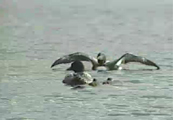Loons and Mercury

Streaming Video - High resolution | Low resolution | RealPlayer Help
Summary
When Environment Canada scientists took blood samples from loons on some pristine Nova Scotia lakes in 1995, they were shocked to find the highest levels of mercury contamination in North America. With loon reproduction in jeopardy, scientists needed to locate the source of the mercury.
Transcript of Video
Narrator
When Environment Canada scientists took blood samples from loons on pristine Nova Scotia lakes in 1995, they had expected to find some mercury contamination... but not the highest mercury levels in North America.
Neil Burgess
We were shocked when we got the results back. The first thing I did was call up the lab and make sure that the numbers were right. It turned out that in the southern part of Nova Scotia - we were working in a national park down there called Kejimkujik - the levels were in fact double what we'd seen anywhere else in North America in loons. We were shocked.
Narrator
The scientists were all astounded by the discovery. The most contaminated of the Kejimkujik loons had blood mercury levels three times greater than the highest levels recorded.
Neil Burgess
We found that the birds with the highest mercury levels were doing the poorest in terms of raising chicks. So there was a strong connection between the mercury levels in the adult birds and how successful they were at raising young - and that made us quite worried.
Narrator
Previous studies had shown that mercury toxicity can stop loons from reproducing. Many of the Keji loons were succeeding at raising chicks just once every four years. The scientists looked to the environment for the sources of contamination.
Neil Burgess
The lakes that we were studying down here in the Maritimes are what I call natural lakes. They don't have industries along the shorelines pumping pollution into them, so the mercury's coming from bedrock and soils that are surrounding the lakes, and through long distance transport of air pollution, much like acid rain.
Narrator
The situation is still being studied, but scientists think that the extraordinarily high level of mercury in the loons is due to a number of factors.
Neil Burgess
Part of it is that those lakes are very acid - there's a lot of wetlands, bogs around them, and those bogs put out a lot of humic acid that makes the lake water very brown, and there's something about that, that makes the mercury much more bio-available. It gets into the fish very easily and gets into the loons in higher levels. Partly it's because those lakes are so acid, the fish grow very slowly, and the size of fish that the loons are eating are very old for the size of them, and they have quite high mercury levels because they're so old.
Narrator
On a diet consisting of highly toxic fish, it seemed a miracle that the loons had survived at all. Until the Keji loons were tested, scientists hadn't considered it possible for loons to survive with such high levels of mercury in their blood.
Neil Burgess
The animals have adapted to a lot of stresses that they've always faced for millions of years. And to be honest, the loons down in Kejimkujik have always faced mercury in the fish there. It's just a question of whether what people have been doing in the last 150 years with industry has added to that mercury level because of air pollution going into the lakes down there.
Narrator
Scientists continue to study the lakes, trying to find out how much of the mercury comes from natural sources and how much is added by pollution... and whether it's enough to tip the precarious balance of the loons.
Neil Burgess
Hopefully if mercury pollution declines significantly we'll eventually see some recovery and we'll see loons doing better as a result.
Narrator
Reducing pollution in the environment would help to ensure that the call of the loon continues to echo on the lakes of Kejimkujik.
Earth Tones is produced in co-operation with Environment Canada.






